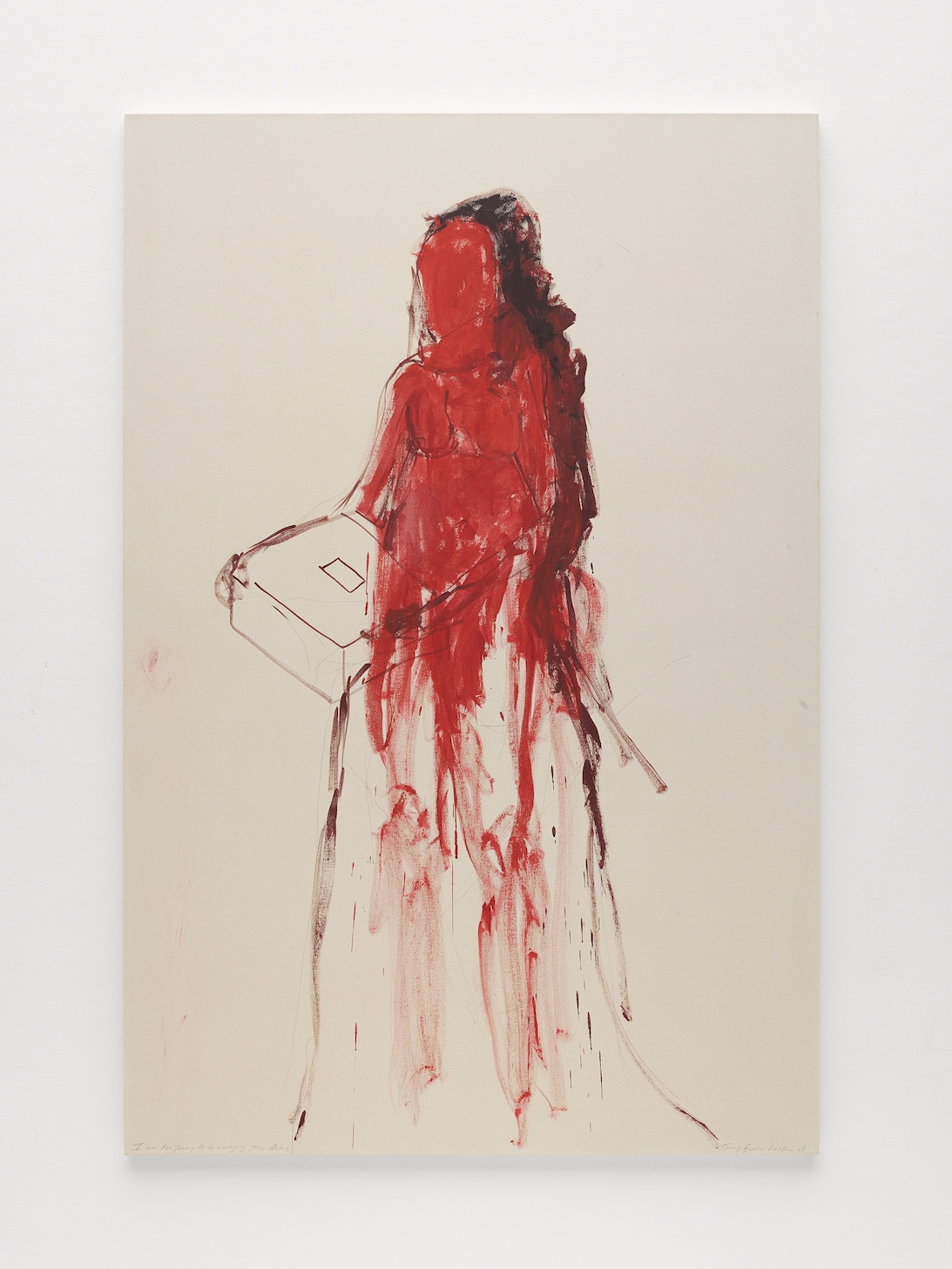Lynn Barber was right when she made this observation of Tracey Emin: ‘If a wound shows any signs of healing, she’ll pick the scab until it starts bleeding again.’ I am reluctant to write this review, because the form tends towards objectivity, and however much I try to separate the critical perspective from the personal, in this case I can’t. When it strikes home, Emin’s work makes it difficult to separate analytical from instinctive responses.
One of the galleries at White Cube’s vast Bermondsey space, rechristened the ‘Ashes Room’, hosts a series of paintings in black and watered-down blue acrylic. Dated between 2016 and 2018, they depict the artist’s grief in the immediate aftermath of her mother’s death. Her scrawled lonely figures are accompanied by plangent titles – Emin has said that words give her paintings an ‘edge’ – like Left Ice cold (2018) and Bye Bye Mum (2018). But it was the phrase I was too young to be carrying your Ashes (2017–18) that got to me.
Throughout her career, Emin has made a spectacle of her life and demanded a reaction from her audience, and I was naïve enough to think that the traumas she chose to share – her rape, her abortion – could always be viewed from a safe critical distance. But in that moment, in front of that painting and its title, I did not sympathise with Emin. Instead I felt an old rage resurface against the bloated blood-red figure carrying the outline of a box, and against the language she uses to describe her pain and mine. It felt the opposite of cathartic – antagonising, even – but at the same time reminded me that anger can be a catalyst for productivity. I watched the other visitors, wondering which of them shares Emin’s experiences, whether they resist or embrace her paintings; who might be wearing the same carefully impassive face as me as they circle the vitrines of archive sketches and texts or watch The Ashes (2018), a three-minute film shot in Emin’s dining room, which settles on a wooden box at the head of the table.
Preceding the Ashes Room is an installation of 50 unframed large-format self-portrait photographs, covering all four walls of the smaller of the two ‘south galleries’, where Emin, from the tilt of her camera, stares down at you through bleary sleepless eyes. On a wall-text outside the room: ‘A deep, deep relentless exhaustion comes over me… No release – every mistake, every minor note of guilt comes back to haunt me.’ Looking at the insomnia etched around her eyelids, I think about how differently we react during periods of grief and mourning, and the kinds of language we use to express our anger, love, desolation. It seems from paintings like I Could Feel You (2018), in which a blue figure looking towards a window that frames the edge of a church, and I wanted to go with you – to Another world (2018), where a female figure painted in black acrylic wears a cross and a halo, that Emin sometimes turns to religion. Or at least to religious art: I Prayed (2017) is a small, simple painting that – in the sketched figure kneeling, the one standing and the line that divides the two – calls to mind Fra Angelico’s The Annunciation (1437–46).
Yet Emin is devoted to the physical body, in its capacity to bear as much pain as love, as seen in a second series of paintings lining the corridor and the largest gallery space. Brought together by a vibrant, umbilical-cord palette of pinks, reds, purples and blacks, they nonetheless suffer in the monumental presence of her bronze sculptures. The Mother (2017) occupies her own room, kneeling, head bent, her moulded body bearing the same rough marks of a soft material manipulated and cast as I lay here for you (2018) and When I Sleep (2018). The contrast between the cold density of When I Sleep’s materials and the pathos of its subject, a crumpled figure in the foetal position, makes me soften. I want to lie down, because I am tired. Among the prostrate nudes, violent painterly gestures, provocative titles and theatrical allusions, When I Sleep presents an image of solitude in mourning, and shows how the sharpest edges lie in that silence where language can no longer operate.
Tracey Emin: A Fortnight of Tears at White Cube, Bermondsey, London, 6 February – 7 April
From the April 2019 issue of ArtReview
